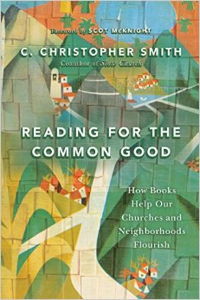
Books were always my first love. As an only child, I spent my childhood wrapped in novels with the sounds of Disney music on in the background. It seems only natural that my love for reading catapulted me into studying English as an undergraduate and then as a graduate student earning a master’s and PhD in literature. In all the focus on theory and dissecting novels like biology experiments, it became easy to think that reading would always (and only) serve a particular end. Pleasure and learning were subsumed into how a book was useful, how it perpetuated ideological categories. I wish I had had C. Christopher Smith’s new book, Reading for the Common Good, in those heady graduate school years as a gentle guide to reading for others.
 Smith’s book, Reading for the Common Good: How Books Help our Churches and Neighborhoods Flourish, is the practical outworking of his previous co-authored book, Slow Church. Where Slow Church left off — advocating a return to incarnational living in church community rather than the McDonaldization of attractional churches — Reading for the Common Good continues. In it, Smith centers the local church; he writes: “For disciples of Jesus, our first and primary vocation is to follow in the way of Jesus as part of a church community.” How do individuals living their vocation within the context of their churches and communities begin to flourish? How do we slow down, invite conversation, and practice ethical, intentional discipleship? How do we learn to love the places where God has put us? Smith argues that answering such questions begins with reading — that reading buttresses the common good.
Smith’s book, Reading for the Common Good: How Books Help our Churches and Neighborhoods Flourish, is the practical outworking of his previous co-authored book, Slow Church. Where Slow Church left off — advocating a return to incarnational living in church community rather than the McDonaldization of attractional churches — Reading for the Common Good continues. In it, Smith centers the local church; he writes: “For disciples of Jesus, our first and primary vocation is to follow in the way of Jesus as part of a church community.” How do individuals living their vocation within the context of their churches and communities begin to flourish? How do we slow down, invite conversation, and practice ethical, intentional discipleship? How do we learn to love the places where God has put us? Smith argues that answering such questions begins with reading — that reading buttresses the common good.
In many ways it seems ludicrous that the idea of reading is a revolutionary and transformative act. Isn’t it too basic for that? For most women in the academy, reading has been part and parcel of a way of life, simply the water we swim in. Yet, reading carefully and well — with an eye to seeing the kingdom of God flourish, not only in one’s own brain, but in the hearts and minds of one’s family, neighborhood, nation, and world — is quite another thing altogether. Our conversations are often either superficially stunted or so obtuse that there is either no “common” or “good” about them. If we use reading only for escape, or only for professional advancement (and cloak our reading in important-sounding academic language), we are no longer serving the common good. We are, rather, serving ourselves.
Although reading is most often an isolated event, it should never be isolating. Reading houses the unique opportunity to build bridges, to offer care and advocacy for our neighborhoods, and to build empathy and compassion for the stranger. Reading is perhaps the very start of revolution — of overturning systems, of seeking the welfare of the cities we’ve been placed in, of being agents of compassion and care to a hurting world.
Reading for the Common Good considers reading in ever-widening concentric circles. Smith traces how reading influences our own individual calling to work, shapes the social imagination, deepens our roots in our local neighborhoods, enables us to engage in civic action, and even helps us care for creation. This outward move from self to neighborhood to world is grounded in seeing the church as a learning organization. Smith stresses that this learning organization is not for the pursuit of knowledge itself, but is propelled by “how we can read together in ways that drive us deeper into action.” Here is another account of how reading and academic study are not superfluous, ivory tower experiences. Rather, reading well can drive us to love our communities — whether that’s our next door neighbor or our academic colleagues — more concertedly.
This isn’t the best book to hand to your friend who hasn’t picked up a book since she read The Scarlet Letter in high school. Reading for the Common Good is a book that presupposes the value of reading but moves the reader from reading as consumption to reading as action. It’s an important shift. Smith’s book invites and initiates deeper thinking and discussion about how reading can help form not only our local churches, but also our neighborhoods and world. It is a book for those who care deeply about not simply consuming — whether that’s fast food, church music styles, or trashy summer reads — but about contributing to the flourishing of God’s kingdom practically and locally. It’s easy to distance ourselves from the idea of consumption when we’re involved in academic work — after all, we spend inordinate amounts of time on detail, theory, history. Yet, when we are only reading to refashion academic knowledge to fit our own ends, then we are not reading for the kingdom of God. We are no longer reading for the common good.
A book about reading wouldn’t be complete without a book list and Smith’s are a treat. Smith wears his learning lightly — effortlessly referencing philosophers, ecologists, theologians, and poets, not to puff up his own reputation, but to drive his curiosity into the wisdom of other writers, and in turn, to use those for the good of the church.
Reading for the Common Good is a quiet, thoughtful book. As a reader passionate about the social benefits of reading to produce empathy and to expand our sense of community and place, I’d hoped for a stronger plea for reading in community, reading carefully, and reading well. If reading does indeed form the basis for seeing the kingdom of God come more fully in our neighborhoods and world, I imagine that many more readers need to be first convinced of this. As a woman fascinated with telling stories, writing, and studying books academically, I don’t need more convincing. But I imagine many of my neighbors do. Our attention spans are down. We flit from Facebook to Twitter to Instagram and scan headlines. As Smith notes, it’s a real thing: continuous partial attention (CPA) means that we’re increasingly surrounded with information, all the while lacking meaningful community and connection. Reading is one way in which we not only gather information, but also teach ourselves how to slow down. When we slow down, we notice, and when we notice, we listen. When we listen, we practice sustained attention. And what better gift is there to give another human being made in the image of God? What better gift is there to give our neighbors and our cities? How might the academy change from a place of ladder-climbing, tenure-track elbowing to one where education is deeply connected with empathy?
Chris Smith practices what he preaches; he is, above all, a generous and attentive listener. After an hour of conversation at the Festival of Faith & Writing in Grand Rapids this spring, I realized what a gift this was, as he later flagged me down to meet another writer with common interests. In Reading for the Common Good, too, Smith helpfully connects the dots between ideas and people, always centering the church as the practical kingdom agent of renewal. If reading is a core spiritual practice, then how we read both Scripture and other books — essentially always in conversation — is indicative of our local church’s health and commitment to seeing the flourishing of our world. Reading is no small diversionary practice.
Reading is, rather, the bedrock of social change. Like bread and wine, the elements feel inconsequential to affect change. Yet, in the repetition of the sacrament we see how, through ordinary means, grace grows and we are transformed. May our reading lives be the same.